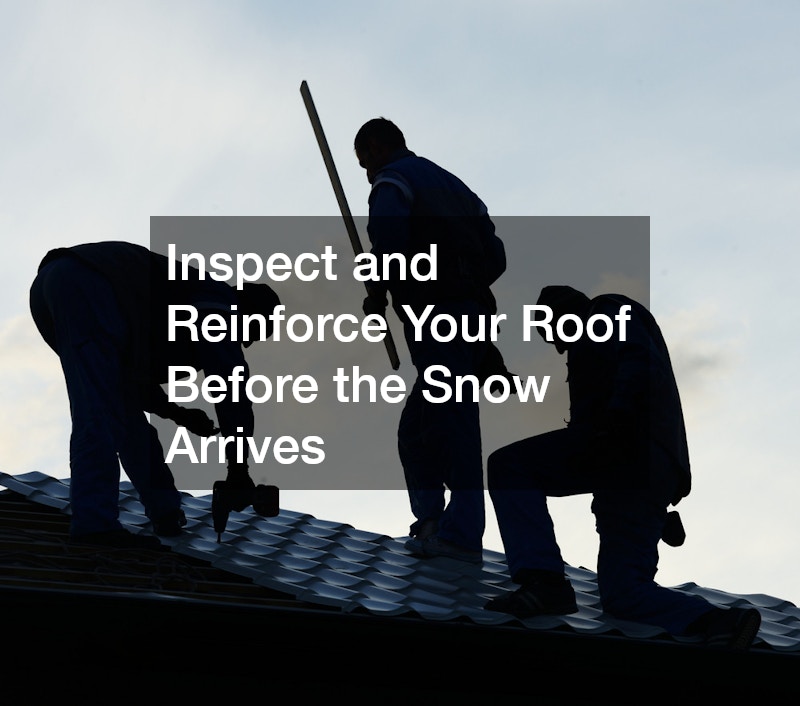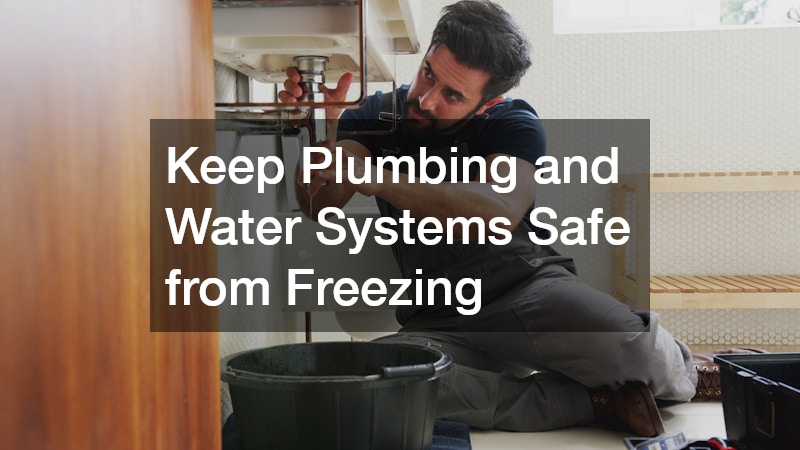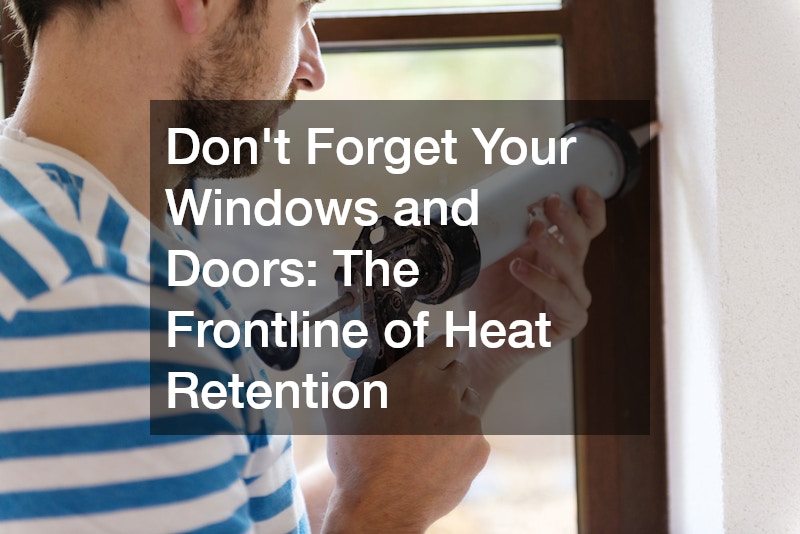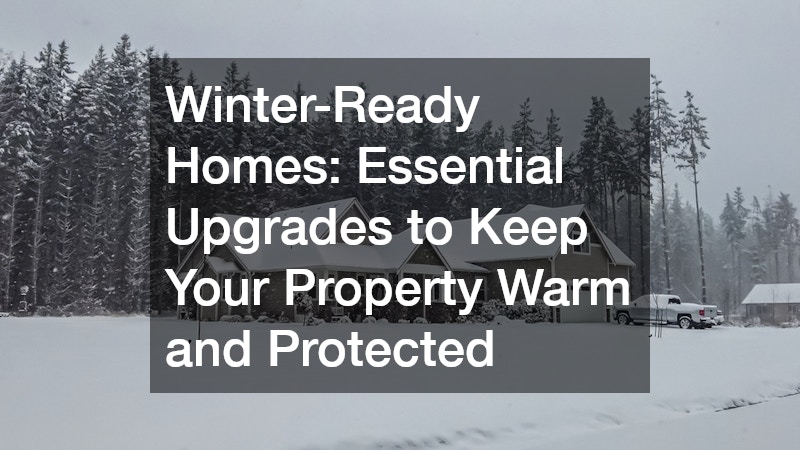
When the temperature begins to drop, many homeowners focus on heating bills and cozying up indoors. However, the real work of keeping your home warm and safe during the cold months starts long before the first frost. Winter weather can wreak havoc on unprepared homes — causing heat loss, frozen pipes, roof leaks, and water damage that can be expensive to repair.
Preparing your property for winter isn’t just about comfort; it’s about protection. A few key upgrades can make your home more energy-efficient, minimize risks of weather-related damage, and improve your overall living experience. Whether it’s scheduling professional roofing services, improving insulation, or reinforcing your basement, each step contributes to a warmer and more secure home.
Check Your Home’s Thermal Envelope
A. Understanding Where Heat Escapes
Every home has a “thermal envelope” — the physical barrier that separates the warm air inside from the cold air outside. This includes your walls, attic, windows, doors, and floors. When insulation or sealing is compromised, warm air escapes and cold air seeps in, making your heating system work harder and increasing your energy costs.
Identifying problem areas early is key. Drafty windows, cold floors, or uneven room temperatures usually indicate weak points in your thermal envelope. Conducting an energy audit, either on your own or through a professional service, can help pinpoint where heat is being lost.
B. Upgrade Insulation for Maximum Efficiency
A well-insulated home is one of the best defenses against winter’s chill. Proper attic and wall insulation prevent heat from escaping upward and keep your living spaces consistently warm. Many homeowners today are opting for spray foam insulation, known for its superior air-sealing and moisture-resistant qualities. It expands to fill gaps and cracks, providing a seamless barrier that other materials often miss.
Hiring experienced insulation contractors ensures you get the right R-value — the measurement of insulation effectiveness — for your region’s climate. They can recommend the best insulation type for attics, walls, crawl spaces, and basements, ensuring that your investment pays off in long-term comfort and energy savings.
C. Seal Drafts and Gaps
Even small gaps around windows and doors can lead to major heat loss over time. Use weatherstripping, door sweeps, and caulk to seal cracks where cold air enters. Pay special attention to attic hatches, outlets, and vents, as these are common but often overlooked leakage points.
Simple fixes like these can significantly boost your home’s energy efficiency — making your heating system work smarter, not harder.
Inspect and Reinforce Your Roof Before the Snow Arrives

A. Why Roof Maintenance Is Crucial
Your roof is your home’s first line of defense against the elements, especially snow and ice. Over time, shingles can loosen, flashing can wear, and gutters can clog — all of which increase the risk of leaks and ice dams during freezing temperatures. These problems don’t just damage your roof; they can cause water to seep into your attic, walls, and ceilings, leading to costly repairs.
B. Schedule a Professional Roof Inspection
Before winter arrives, schedule a thorough checkup with local roofing services. Professionals can inspect shingles for cracks, ensure flashing is secure, clean gutters and downspouts, and repair any existing damage. This proactive approach helps prevent roof leaks and ensures that your drainage system works efficiently when melting snow begins to flow.
Routine roof maintenance not only protects your home but also extends the lifespan of your roofing materials, saving you thousands in potential replacement costs.
C. Consider Long-Term Roof Improvements
If your roof is nearing the end of its lifespan, consider upgrades that enhance both durability and insulation. Options like energy-efficient shingles, reflective coatings, and proper attic ventilation reduce moisture buildup and help maintain a consistent indoor temperature. The initial investment pays off by lowering energy bills and preventing future damage.
Waterproof Your Basement and Foundation
A. Understanding Winter Moisture Risks
Winter brings frequent freeze-thaw cycles that can stress your foundation and create cracks. When snow melts, water can seep into your basement, especially if drainage systems aren’t working properly. Over time, this can lead to mold growth, structural damage, and a damp environment that affects your home’s air quality.
B. Invest in Basement Waterproofing
One of the smartest winter-prep moves is investing in basement waterproofing services. These professionals can apply sealants, install drainage systems, and add sump pumps to redirect water away from your foundation. A dry basement not only prevents costly water damage but also adds to your home’s comfort and value.
Waterproofing solutions may include:
-
Interior sealants: Protect walls from minor seepage.
-
Exterior membranes: Keep moisture from penetrating the foundation.
-
Drainage systems: Prevent water accumulation near the foundation walls.
C. Seal and Protect Exterior Concrete
Driveways, walkways, and patios endure heavy wear during winter. When moisture seeps into porous concrete and freezes, it expands, causing cracks and surface spalling. Applying a professional-grade concrete sealing product creates a protective layer that prevents water absorption and damage.
It’s best to complete concrete sealing before the first frost to allow proper curing and ensure year-round protection.
Keep Plumbing and Water Systems Safe from Freezing

A. Winter Plumbing Problems to Watch For
Frozen pipes are one of the most common and damaging winter emergencies. When water freezes, it expands and can cause pipes to burst — leading to flooding and thousands of dollars in repairs. Areas most at risk include pipes in basements, attics, and along exterior walls.
B. Preventive Steps and Professional Help
Here’s how to keep your plumbing safe:
-
Insulate exposed pipes with foam sleeves or heat tape.
-
Let faucets drip slightly to relieve pressure during extreme cold.
-
Keep cabinet doors open to keep circulating around pipes.
-
Disconnect garden hoses and drain outdoor faucets.
For comprehensive protection, schedule a maintenance visit with a local plumbing company. They can inspect your entire system, ensure pipes are properly insulated, and check for leaks or corrosion that could worsen in cold weather. They may also service your water heater to ensure it performs efficiently during heavy winter use.
Exterior Upgrades for Weather Protection
A. Repaint and Refinish for Durability
Cold temperatures, snow, and moisture can take a toll on your home’s exterior paint. Peeling or cracked paint exposes siding and trim to rot and rust. Hiring professional exterior painting contractors before winter arrives ensures your home’s surfaces are sealed and protected.
A fresh coat of high-quality, weather-resistant paint provides more than curb appeal — it acts as a barrier against moisture, preventing wood and metal deterioration during the freeze-thaw season.
B. Strengthen Your Fencing and Outdoor Structures
Winter winds and heavy snow can damage fences, decks, and sheds. Conduct a thorough inspection for loose boards, rusted hardware, or unstable posts. A reputable fence company can make necessary repairs or replacements to reinforce your fence before winter storms arrive.
To prolong your fence’s life:
-
Apply a sealant or stain to protect wood from moisture.
-
Check metal fences for rust and repaint if necessary.
-
Clear snow buildup to avoid bending or collapsing.
C. Store and Protect Outdoor Equipment
Outdoor furniture, gardening tools, and recreational equipment should be safely stored before the first snowfall. Using mobile storage containers is a practical way to protect these items from the elements while keeping your garage and basement clutter-free.
Mobile storage units come in various sizes and can be placed conveniently on your property, offering weatherproof storage that’s accessible yet secure throughout the season.
Improve Interior Comfort and Flooring Warmth
A. Flooring Choices for Cold Weather
The right flooring can make a noticeable difference in how warm your home feels during winter. Cold surfaces like tile or hardwood can make rooms feel chilly even when the thermostat is set high. Consulting a professional flooring company can help you choose materials that retain warmth, such as carpet, luxury vinyl planks, or engineered wood with insulation underlays.
Radiant floor heating is another popular option that provides even, consistent warmth from the ground up. While it requires a higher initial investment, it greatly enhances comfort and energy efficiency.
B. Add Warmth Through Design and Maintenance
Beyond material choice, simple upgrades can make your floors cozier:
-
Add thick area rugs or runners in high-traffic areas.
-
Use rug pads for added insulation and comfort.
-
Keep floors clean and dry to prevent slips during wet weather.
Proper maintenance also extends the lifespan of your flooring, ensuring it remains durable and comfortable through many winters to come.
The Role of Professional Contractors in a Winter-Ready Home

While DIY solutions can help with basic maintenance, many aspects of winterizing a home require professional expertise. Specialists can identify hidden problems and deliver long-lasting fixes that homeowners might overlook.
For example:
-
Insulation contractors can ensure your attic and walls meet energy-efficiency standards.
-
Roofing services can detect structural weaknesses that may lead to leaks under heavy snow.
-
Basement waterproofing services can prevent foundation damage from ice and moisture.
-
A local plumbing company can insulate and maintain pipes to avoid costly water damage.
Partnering with trusted professionals ensures that your home is thoroughly prepared, reducing your stress when severe weather strikes.
Sustainable and Cost-Efficient Winter Upgrades
Winterizing your home doesn’t just protect it — it’s also an opportunity to invest in sustainability. Eco-friendly improvements can lower your energy bills and reduce your environmental footprint.
Consider these cost-saving upgrades:
-
Energy-efficient insulation materials: Recycled fiberglass and cellulose insulation are both sustainable and effective.
-
Low-VOC exterior paints: These minimize harmful fumes while providing durable protection against moisture.
-
Programmable thermostats: Automatically adjust indoor temperatures for maximum comfort and efficiency.
-
Sealing and waterproofing: A well-sealed home traps heat and prevents air leakage, reducing the need for constant heating.
While these upgrades may require an initial investment, they quickly pay off through lower energy consumption and a more comfortable indoor environment.
Don’t Forget Your Windows and Doors: The Frontline of Heat Retention

Windows and doors are often overlooked when preparing for the arrival of winter, yet they play a crucial role in retaining indoor heat. Even small air leaks can significantly increase heating costs and reduce indoor comfort. Inspect window seals and weatherstripping to identify worn-out or cracked areas. Replacing old seals or applying new caulk can make a noticeable difference in temperature control.
Consider upgrading to double- or triple-pane windows for improved insulation. If replacement isn’t in the budget, thermal curtains or window insulation kits offer affordable alternatives. Door sweeps, draft stoppers, and storm doors add another layer of protection, helping to block cold drafts from entering your home. These simple yet impactful improvements help your HVAC system run more efficiently and keep every room cozy through the coldest nights.
Maintain Heating Systems for Maximum Efficiency
Your heating system is the backbone of your home’s winter comfort, so regular maintenance is essential before temperatures plummet. Schedule an annual inspection with a certified HVAC technician to ensure your furnace or boiler operates efficiently. A professional can check for worn-out components, clean filters, and calibrate thermostats to optimize performance.
Homeowners should also consider:
-
Replacing air filters every 1–3 months to improve airflow and indoor air quality.
-
Bleeding radiators or flushing boilers to prevent air blockages.
-
Installing a programmable or smart thermostat to automatically regulate temperatures based on occupancy.
-
Cleaning vents and ducts to remove dust buildup that hampers efficiency.
An efficient heating system not only saves energy but also reduces the risk of unexpected breakdowns during freezing weather. This proactive care keeps your home reliably warm while minimizing repair costs.
Prioritize Attic Ventilation and Airflow
While insulation prevents heat from escaping, ventilation ensures that your home “breathes” properly. Many homeowners mistakenly believe sealing everything completely will trap heat, but without proper attic ventilation, warm air can condense, causing moisture buildup, mold growth, and even ice dams. Balanced airflow — with intake vents along the soffits and exhaust vents near the roof ridge — helps regulate temperature and humidity.
If your attic feels stuffy or shows signs of condensation, consult an insulation or roofing contractor to evaluate the ventilation system. They may recommend adding ridge vents or attic fans to improve circulation. Proper airflow not only extends your roof’s lifespan but also enhances indoor air quality and keeps heating systems running efficiently. A well-ventilated attic is essential for a truly winter-ready home.
Prepare for Power Outages and Emergency Situations
Winter storms can bring down power lines and disrupt utilities for hours or even days. Being prepared ensures your family remains safe and comfortable even during unexpected outages. Start by assembling an emergency kit containing flashlights, batteries, bottled water, non-perishable food, blankets, and a first-aid kit. Keep backup heating options such as portable propane heaters or a generator (used safely and per manufacturer guidelines).
Other essential steps include:
-
Installing surge protectors to safeguard electronics.
-
Keeping your phone and power banks fully charged before major storms.
-
Knowing how to manually open your garage door in case of a power failure.
-
Checking smoke and carbon monoxide detectors to ensure they’re functional.
Being proactive about emergency readiness adds another layer of security, helping your household stay warm, safe, and prepared no matter how severe winter becomes.
Conclusion: A Cozy, Protected Home All Winter Long
Preparing your home for winter is one of the best investments you can make for both comfort and protection. By addressing insulation, roofing, waterproofing, plumbing, and exterior maintenance before the cold sets in, you’re not only preventing costly damage but also ensuring your family enjoys a warm, safe environment all season long.
Hiring the right professionals ensures that every detail is handled properly.
A winter-ready home is a resilient home. With timely upgrades and expert care, you can face the cold months confidently, knowing your property is well-protected from top to bottom.



